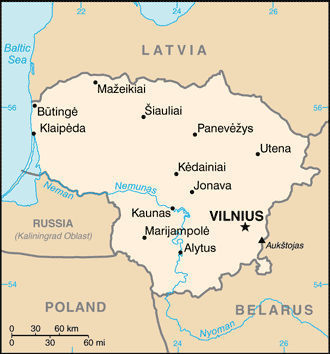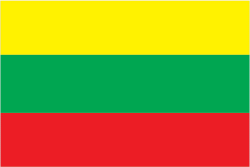| Republic of Lithuania Lietuvos Respublika
Location northeastern
Europe
Bordered By Latvia, Belarus, Poland, Russia

Area 25,174 sq mi
(65,200 sq km)
Coastline 56 mi (90 km)
Highest Point Aukstojas; 964 ft (294 m)
Lowest Point sea level
Natural Resources peat, amber

Nationality Lithuanian
Population (July 2013 est) 3,505,738
Largest Cities Vilnius
Ethnic Groups Lithuanian, Polish,
Russian
Religions Roman Catholic, Russian
Orthodox
Languages Lithuanian (official), Polish,
Russian
Capital Vilnius
Form of Government parliamentary
democracy
Present Constitution Adopted October 25,
1992
Chief of State President Dalia
Grybauskaite (since July 12, 2009)
Head of Government Prime Minister Saulius
Skvernelis (since December 13, 2016)
Cabinet Council of Ministers appointed by
President upon recommendation of Prime Minister and
approval of Parliament
Legislature unicameral Parliament (Seimas)
Judiciary Supreme Court, Constitutional Court
Local Administration 60 municipalities (savivaldybe)
Currency Litai
Per Capita Income $22,600
Industries metal-cutting machine tools,
electric motors, television sets, refrigerators and
freezers, petroleum refining, shipbuilding (small ships),
furniture, textiles, food processing, fertilizers,
agricultural machinery, optical equipment, electronic
components, computers, amber jewelry
Agricultural Products grain, potatoes,
sugar beets, flax, vegetables; beef, milk, eggs; fish
Export Commodities mineral
products, machinery and equipment, chemicals, textiles ,
foodstuffs, plastics
Import Commodities mineral
products, machinery and equipment, transport equipment,
chemicals, textiles and clothing, metals
Independence from the Soviet
Union Achieved September 6, 1991
National Holiday Independence Day; February 16
(the date in 1918 that Estonia declared its independence
from Soviet Russia)
Flag yellow symbolizes golden fields, as
well as the sun, light, and goodness; green represents
the forests of the countryside, in addition to nature,
freedom, and hope; red stands for courage and the blood
spilled in defense of the homeland

SEE ALSO
Latvia
Poland
Russia
Questions or comments about this
page?
|
 SKC Films Library
SKC Films Library

